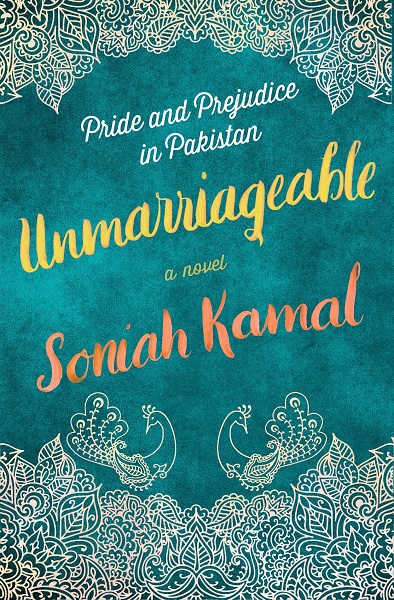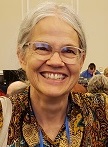 It is my pleasure to introduce to you author Natalie Jenner and her debut novel, The Jane Austen Society. – Rachel Dodge
It is my pleasure to introduce to you author Natalie Jenner and her debut novel, The Jane Austen Society. – Rachel Dodge
Let’s begin with a description of the novel to whet your literary appetites:
One hundred and fifty years ago, Chawton was the final home of Jane Austen, one of England’s finest novelists. Now it’s home to a few distant relatives and their diminishing estate. With the last bit of Austen’s legacy threatened, a group of disparate individuals come together to preserve both Jane Austen’s home and her legacy. These people—a laborer, a young widow, the local doctor, and a movie star, among others—could not be more different and yet they are united in their love for the works and words of Austen. As each of them endures their own quiet struggle with loss and trauma, some from the recent war, others from more distant tragedies, they rally together to create the Jane Austen Society.
Introducing Natalie Jenner, author of The Jane Austen Society:
I first “met” Natalie Jenner online last year, and we’ve since formed a lovely friendship—one that I foresee extending into the future for a very long time. That’s the thing about Jane Austen devotees: We always seem to find one another, even if we’re from different parts of the world, because of our shared love for Jane, her life, and her work. That magic is also what immediately drew me to Natalie’s debut novel, The Jane Austen Society, a story about a group of people who are drawn together based on their love for all things Austen and a desire to protect her legacy.
As a fellow writer, I couldn’t wait to pick Natalie’s brain about how she came up with such a beautiful concept for a novel. Her answers to my questions gave me a further glimpse into her creative process and the story of how this novel came to be. I’ve loved getting to know Natalie this past year. And I hope, once you read her interview, you’ll feel like you know her, too.
Q: When did you first discover Jane Austen and how have her books touched your life?
A: I discovered a beautiful 1976 Dutton edition of Pride and Prejudice on my parents’ bookshelves when I was a child, and I remember being besotted by the fact that the book came in a box with a ribbon that ran through it, by the wonderful ink and wash illustrations by Isabel Bishop, and most of all by that crazy dialogue-heavy opening scene with Mr. and Mrs. Bennet that reads just like a screenplay.
Austen’s books have touched my life in many ways: as a teenager, they introduced me to female characters with little social agency yet huge reservoirs of inner conviction and resilience and hope. As I started my own adult and family life, books like Persuasion and Sense and Sensibility in particular showed me a side to the pathos of real grown-up life that seemed missing from so much modern culture. And most recently, Austen helped me through a challenging time in middle age by her personal example of living with chronic pain and grief, and writing through illness and despair.
Q: What initially inspired you to write The Jane Austen Society? (Do you remember where you were when the idea first came to you?)
A: I remember exactly where I was. I had been spending a “quiet year” rereading all of Austen, looking for solace when my husband was diagnosed in his early 50s with a very rare and incurable form of lung disease. This led me to start reading as many books about her life as I could find, which in turn inspired me to take a bucket list trip to Bath and Chawton to literally walk in Austen’s footsteps, as well as attend my first JASNA regional event. I was also binge-watching a lot of Downton Abbey and British television during this time, including a home real estate series called Escape to the Country. When my husband’s lung decline started to stabilize following experimental treatment, I remember feeling hope for the first time in two years of what was frankly a medical nightmare. Along with hope, I was also surprised to find myself yearning to write again, after locking five unpublished manuscripts from my 30s away in a drawer many years ago. Initially I was going to write about a group of people trying to rescue an old British estate house, similar to Downton Abbey. But my daughter very clearly remembers me one day, out of the blue, looking up from my reading and saying very simply instead, “I am going to write a book about a group of people trying to save Jane Austen’s house.” And that is pretty much still the tag line for my book.
Q: At what point did you decide to write it as a fictional account? Did the story come to you all at once or did it slowly build as you planned and drafted?
A: Interestingly, because my first impulse was to write something completely fictional about a made-up house, the idea of any of it being related to Austen only came upon the heels of that. So, fictional first, then Austen second. I conceived of eight to ten characters, half men and half women, and I gave them jobs (as a career coach in my other life, I know how important one’s job is to one’s identity, and in looking back, I think that must be why so much of the action stems from the fact of someone being a doctor, or a lawyer, or a servant girl).
That was all the planning that I did in advance. When I sat down one day to write, an image immediately came to mind of a man, tired and lonely and sad, lying back on the very stone wall in the churchyard of St. Nicholas where I had rested the fall before when visiting Chawton. I remember typing that first chapter, having this man meet the Austen fan from America who has descended on his village, making up his life story, having him start reading a copy of Pride and Prejudice from the library (that moment we can all relate to, that very first “hit”), and then I wrote the words “He was becoming quite worried for Mr. Darcy” and right away I knew what my book was really going to be about. People in love with Jane Austen, and then learning to love themselves. I write completely without a plan or outline of any kind—I love it, it’s so exhilarating, and it lets my characters drive the action, so everything always comes as a complete surprise to me. That’s where all the fun in writing is for me. Revision is the penance for the fun.
Q: How do your characters “introduce” themselves to you? What is the process you use to create and develop them?
A: My characters appear to me completely formed and ready, in terms of their appearance but also their temperament, personality, and mannerisms. I can’t explain it, and I haven’t asked other authors how common that is, probably because I am afraid of the answer! I can immediately picture everything about my characters when they first appear to me except—strangely—the exact features of their face. Their faces always remain a little blurry, but that does enable me to do stunt-casting later on for my dream movie or tv version.
Q: Your character names are perfectly charming! How did you come up with their names?
A: This is also a strangely intuitive part of the process, as the names for the most part just pop up in my mind. But I do remember struggling with Dr. Gray’s first name, Benjamin, because I wanted it to be traditional and strong and pleasant, but also not overly common. And I am going to give you a little nugget: I had already picked Mimi for the Hollywood actress’s name, and it was only later in researching the name that I learned that “Mimi” is also a diminutive for “Mary Ann”—which was, obviously, so perfect, and a sign that I just could not ignore. Once I had all the names in place, and because I did not want to step on any real-life people in creating this fictional work about a very real society and place, I did go through census records online for the village of Chawton, trying to the best of my ability to ensure that no real villagers now or in the past shared surnames with any of my characters, just to avoid any unnecessary confusion.
Q: What was your research process for this book and what sources did you consult? Did you visit any Jane Austen sites in England?
A: So I had actually done a year of what I now call “unintentional research” when I was sitting in my garden rereading Austen and then reading every book I could find on the story of her life. I was particularly impacted by the following books: Among the Janeites by Deborah Yaffe, Jane’s Fame by Claire Harman, and Reading Austen in America by Professor Juliette Wells, all of which really got me thinking about Austen fandom and how it has manifested itself historically; and Caroline Knight’s memoir, Jane & Me: My Austen Heritage, which introduced me to the more private, familial side of Chawton House’s history.
Throughout my life I have visited and revisited many Austen sites, but during this particular time, I was fortunate to get to spend a week on my own in Hampshire. Every morning I would make the same walk to Chawton from Alton that Austen herself used to make. I would be the first person to arrive at the Jane Austen’s House Museum when it opened in the morning, and the last person to leave Chawton House at the end of the day. All of this “research” was done before I even had an inkling that I was going to write a book about any of it one day!
Q: Are there any characters or storylines in the book that strike a chord with you personally? Do you have a favorite character?
A: I love this question, because yes! Adeline the war widow can be a polarizing figure but her total immersion in her grief really resonated with me—it was like a funhouse mirror reflection of the great parts of her character: the intensity, the curiousity, the always-up-for-a-fight. She’s just so independent and her own person, and I loved that about her. I also loved Dr. Gray, who is propping this entire little village totally at the expense of his own emotional healing, which seemed so human to me. But my real soft spot is for Evie: she is my daughter and myself at that age, so single-mindedly focused on her intellectual growth and academic ambition, and just waiting, impatiently, for her moment in the sun.
Q: Where and when do you get your writing done? Can you share any rituals or quirks you have as a writer?
A: My main quirk as a writer is the fact that I can and do write anywhere, anytime. I gave up my home office when my husband started working from home, and so far I have not yet been able to get it back! I write by the fireplace and big window in the living room, in bed, at the dining room table, by the pool, and last summer I treated myself to an 8 foot by 8 foot writing shed in the garden. My absolute favourite time to write is when I first wake up, usually around 5 am if I am in the middle of a book and can’t stand the suspense myself of what’s going to happen next. All I need when I write is just my laptop and sometimes a cup of English breakfast tea to keep me going.
Q: What do you hope the worldwide Jane Austen community will gain from reading this book?
A: My goal for this book is even more global than that: I want everyone, Austenites and strangers to Austen alike, to reaffirm for themselves, through the experiences of my characters, the critical and essential role of hope in all our lives. As I say in the book, sometimes hope is all we have: but hope can also sometimes be just enough. I know it was for me. For Austenites in particular, I would love for them to appreciate and celebrate all of our individual and collective efforts in keeping the works of Austen so thriving and alive.
Q: If you could step into one of Jane Austen’s novels, which one would it be and which character would you like to play?
A: Elizabeth Bennet. All the way. In fact, I’m already halfway there in my mind as I say this. She is undoubtably the most delightful, charismatic, and authentic character in all of literature.
Q: Who is your favorite actor from the new Emma movie and what do you like most about his/her performance. (I think I know the answer, but I can’t wait to hear your thoughts!)
A: You are a good guesser because, yes, it’s Mr. Johnny Flynn. I was so averse to his casting announcement, and superficially so—he struck me as having a very young, British-boy-band, foppish manner. My Mr. Knightley (my favourite romantic figure in all of Austen) is tall, and imposing, and so smart. What I loved about Flynn’s performance in the new Emma movie was how he retained the imposing manner in any room, but gave it a quieter confidence and vulnerability that I hadn’t seen before. I could feel how much he wanted to love and be loved, and to start a family, and I just found that all so incredibly romantic and touching.
Q: Is there anything else you would like to tell us about this book?
A: I would add that I tried while I was writing, and in the dreaded revising, to throw in as many little “Easter eggs” as I could, so that the more hard-core Austen fans could have fun picking up on little allusions and parallels to events, characters, and romances from Austen’s own works. Although over the course of three drafts many of these parallels were intentional, some still surprised even me. Which, as I said before, is the total joy and fun of writing.
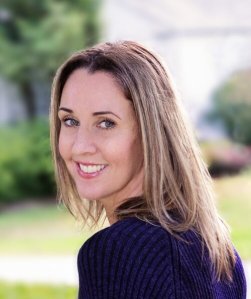
Natalie Jenner
AUTHOR BIO:
Natalie Jenner is the debut author of THE JANE AUSTEN SOCIETY, a fictional telling of the start of the society in the 1940s in the village of Chawton, where Austen wrote or revised her major works. Born in England and raised in Canada, Natalie graduated from the University of Toronto with degrees in English Literature and Law and has worked for decades in the legal industry. She recently founded the independent bookstore Archetype Books in Oakville, Ontario, where she lives with her family and two rescue dogs.
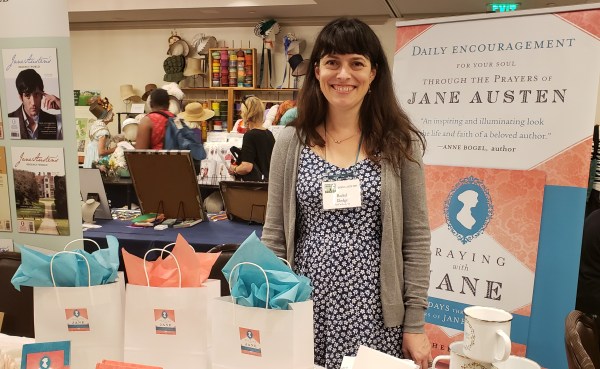
Rachel Dodge at the JASNA AGM in Williamsburg, October 2019
About Rachel Dodge, the interviewer: Rachel Dodge is a college English professor and the author of Praying with Jane: 31 Days Through the Prayers of Jane Austen and The Anne of Green Gables Devotional: A Chapter-by-Chapter Companion for Kindred Spirits (November 1, 2020). . You can find her online at http://www.RachelDodge.com.
WEBSITE | TWITTER | FACEBOOK | INSTAGRAM | GOODREADS
AUDIOBOOK NARRATED BY ACTOR RICHARD ARMITAGE:
The full unabridged text of THE JANE AUSTEN SOCIETY was read by the distinguished English film, television, theatre and voice actor Richard Armitage for the audiobook recording. Best known by many period drama fans for his outstanding performance as John Thornton in the BBC television adaptation of North and South (2004), Armitage also portrayed Thorin Oakenshield in Peter Jackson’s film trilogy adaptation of The Hobbit (2012 – 2014).
Link to YouTube audiobook excerpt: https://youtu.be/OJ1ACJluRi8
PURCHASE LINKS:
Just after the Second World War, in the small English village of Chawton, an unusual but like-minded group of people band together to attempt something remarkable.
You may order your copy of The Jane Austen Society here:
AMAZON | BARNES & NOBLE | BOOK DEPOSITORY | INDIEBOUND | AUDIBLE | GOODREADS | BOOKBUB
JOHN THE BLOG TOUR!
Join the virtual online book tour of THE JANE AUSTEN SOCIETY, Natalie Jenner’s highly acclaimed debut novel May 25 through June 30, 2020. Seventy-five popular blogs and websites specializing in historical fiction, historical romance, women’s fiction, and Austenesque fiction will feature interviews and reviews of this post-WWII novel set in Chawton, England.
BLOG TOUR SCHEDULE:
May 25 Jane Austen’s World
May 25 Austenprose—A Jane Austen Blog
May 26 Frolic Media
May 26 A Bookish Affair
May 26 Courtney Reads Romance
May 26 Margie’s Must Reads
May 26 The Reading Frenzy
View the Rest of the Tour Schedule in the Side Bar – The blog tour lasts until June 30th!
Read Full Post »
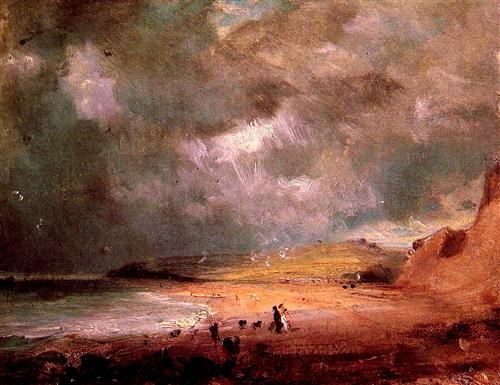





 When I agreed to review this novel, I received a traditional book and an audio book. I “read” both and had thoughts about each of the treatments. Who can argue with listening to Richard Armitrage reading a story set in early 20th century England? Not I. Think of me as a fan struck by his rich baritone voice, which can be transformed to that of a 16-year-old girl. Richard’s pacing in reading the book is effortless, clear, and easy to follow. He acts the voices of the characters so that we know exactly who’s talking at any time:
When I agreed to review this novel, I received a traditional book and an audio book. I “read” both and had thoughts about each of the treatments. Who can argue with listening to Richard Armitrage reading a story set in early 20th century England? Not I. Think of me as a fan struck by his rich baritone voice, which can be transformed to that of a 16-year-old girl. Richard’s pacing in reading the book is effortless, clear, and easy to follow. He acts the voices of the characters so that we know exactly who’s talking at any time: About Natalie Jenner:
About Natalie Jenner:





